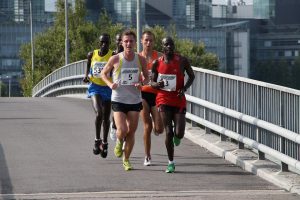The challenges of marathon running
Pilates for marathon runners, it isn’t something you will read about in many running magazines. If this is your first marathon, or even if you are a veteran, it is worth looking at all options. Sport’s science can tell us a lot about the demands marathons place on the body. And whilst many people focus on clocking up the miles, there are other elements that will help performance. Flexibility, posture and core strength will benefit any long distance runner.
We take a look at how Pilates can help with all of these.

Pilates for Marathon Training
Pilates for Marathon Runners – running efficiency
The key to running your best marathon is preserving as much energy as possible for as long as possible. I’m sure you have heard of the dreaded wall. This is a metaphor for that feeling many people get a few miles from the end when their energy stores are getting depleted.
Obviously, learning about good nutrition and hydrating well before and during a marathon run is all important. Many blogs and magazines cover this in detail. But something that is massively overlooked is running form. Even if you have good posture in real life, it doesn’t mean that your running posture (dynamic posture) will be efficient.
If you watch an experienced runner they look graceful and look like they are running lightly on the ground. Their head will be upright, the elbows will be close to their sides and their stride will be smooth. This is because good biomechanics helps to preserve energy and gives a competitive advantage.
How Pilates will help
Pilates improves flexibility through the use of slow and deliberate movements. Because there is movement involved during the stretch, this receives the name of dynamic flexibility.
Most athletes from all different sports incorporate dynamic flexibility into their training. Runners use it more than the traditional static stretching that we are familiar with from our school PE classes. By stretching out the muscles in an active way they are better prepared for dynamic activities such as running.
The added flexibility you can gain from Pilates can help maximise your stride length (which can make a big difference over 26 miles). And staying flexible always helps to guard against injury.
Pilates is one of the best types of exercise for improving posture. As part of a Pilates session, you will be taught about spinal alignment. Good spinal alignment will help with your running as it will help you maintain a more balanced running style.
A fundamental part of Pilates is the development of core strength. This means that the muscles in the trunk of your body work together to stabilize and support your spine. Core strength is key to good long distance running. When most runners become fatigued, their trunk will tend to rotate excessively.
Trunk rotation is wasted energy. By developing good core strength through Pilates it will enable you to minimise lateral rotation of your trunk whilst running.
In fact, the benefits of Pilates are numerous. It is also strangely relaxing and restorative and can help to break up a repetitive routine of pounding the pavement. Try it, and experience the results for yourself. You won’t regret it.
We hope this information is useful for you. If you have any questions about our treatments, please contact us. You can find us in Mill Hill Broadway and Islington. If you like this blog, please share! We are always happy to help.



